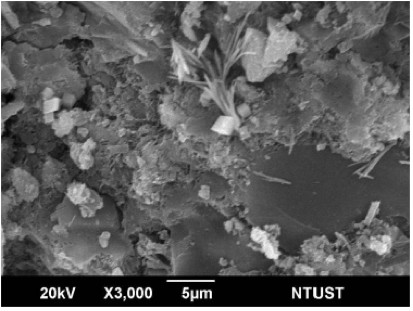- NEEDLES & SHIELDS OF CONCRETE CRYSTALLINE SYSTEMS -
In the order to specify best concrete mix design for production of concrete sewer pipes, company [1] proposed to
compare conventional concrete mix, High-Alumina cement based concrete mix, and conventional concrete mix with
Kalmatron® KF-A admixture. Concrete petrography testing is used to evaluate structural essentials of every concrete
mix design by the shapes of crystalls.
dynamic modulus of elasticity, ultrasonic pulse of velocity, and chemical resistance to Acid and Alkaline solutions.
Corresponding those test results (see below) to the concrete petrography, concluded to very important observations:
probabilistic nature of multi centered crystallization. With a convenient simplification we can see C3S (alite) in the
largest amounts of equidimensional colorless grains; C2S (belite) represented in basic shapes from thin prisms to linear
growths, and C4AF as a solid solution amongst the other crystals.
crystalline field is low, as shown in photograph 2. Those crystalline structures are the most unstable in response to
changes in temperature, humidity, and chemicals. The potential integral area of the surface of such a crystalline field is
much larger than any field formed by spontaneously grown crystals. Hence, the less integral area of crystalline surface,
the higher its density and resistance to rupture and corrosion. The fineness of the cement or its hyper hydration is the
key operator in that process.
and the plates of C3A presented by quadrangular prisms. On micrographs C3A appears as a prismatic dark interstitial
material, and is often in the form of flat plates individually surrounded by the calcium silicates hydrates. Ca(OH)2 as a result
of hydrolyses, always forms hexagonal plates as thin as 0.001 µm. Eventually, they merge into a massive, continuously
crystalline deposit. At the early stage of crystallization, those prisms can be dissolved with an Alkaline Solution.
Portland Cement. That test reading was taken in earlier terms of C3A maturing and should not be considered a final result for
that test.
by continuous plates or opened shell-like new growths.
It shows that Calcium Silicate Hydrates exist as a layered structure: e.g., montmorillonite and halloysite, containing
fibrous particles, flattened particles, and a reticular network of opened shells. Separate tetrahedral shaped particles
result from overly concentrated mineral solutions, which become the centers of crystallization during additional hydration.
areas. These types of crystals provide micro-sewing of the structural voids and are widely used in the industry for rehabilitation
of damaged or aged concrete.
Such concrete internal densifying increases its compressive strength up to 2 times and liquid impermeability up to 2-3
times. That concrete may look aged, but its functionality is prolonged for decades.
resistance to corrosions, and durability, compared on a time counted from cement hydration beginning.
1
2
3
Below are the test results of concrete specimens tested for chemical resistance to Acid and Alkaline
solutions, where:
Specimens KF-A f avg. – Made with KF-A on a plant;
Specimens KF-A lab – Made with KF-A in a laboratory;
Specimens Pol - Made with Ordinary Portland Cement;
Specimens AL – Made with High Alumina Cement.
____1. The more needle-like crystals concrete contains, the higher fragility, permeability, and lower resistant to corrosions
that concrete is. Compressive strength is high on 28th day, which is irrelevant to the required properties of durability.
____2. The more flat crystals concrete contains, and the fewer needle-type crystals, the stronger, more impermeable, and
resistant to corrosions that concrete is.
[1] – “TESTS RESULTS OF KALMATRON® KF-A CONCRETE FOR PRODUCTION OF SEWAGE PIPES” PROVIDED BY “TONDALEE TRADING CO., LTD”
8F,219, SECTION 1,
TUNG HWA S. ROAD TAIPEI, TAIWAN, R.O.C.
Phone: 886-2-2721-8069
CRYSTALLINE CONCRETE STRUCTURES WITH AND WITHOUT KALMATRON® KF-A
USA patent #5,728,208
Inventions of the 21-st Century















